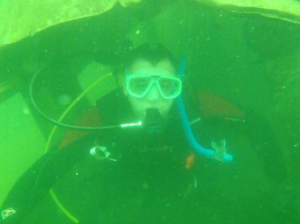Medical Physics Seminar – Monday, April 25, 2022
Development of an Ultrasound-based Image Guidance Radiotherapy System for Motion Management in the Liver

Sydney Jupitz
Graduate Student of Dr. Bryan Bednarz
Radiation therapy is a common and effective treatment technique for liver tumors. In this region of the body, motion management strategies often need to be employed to account for patient breathing motion during radiotherapy treatments. Ultrasound offers a promising real-time, non-invasive and non-ionizing imaging solution for motion management. Our team developed a MR-compatible, 3D ultrasound transducer with hands-free operating capabilities. With this transducer, simultaneous ultrasound and MR image acquisition can be utilized for monitoring patient breathing motion during a pre-treatment imaging session. This information can then be used to inform decisions during radiotherapy treatment under ultrasound-guidance alone. In this way we utilize the real-time capabilities of ultrasound while exploiting the complementary soft-tissue contrast mechanisms of ultrasound and MRI. This talk will review key aspects of this image-guidance workflow as implemented during a healthy volunteer liver imaging study.
No-carrier-added 69/71Germanium and 61/64Copper for Radiotracer Development

Christopher Kutyreff
Graduate Student of Dr. Jon Engle
With a growing number of radiotracers approved for clinical use, development of new positron-emitting radionuclides is warranted. Two novel, PET-imageable radionuclides are developed and reported for medical applications.
First, a growing body of literature describing the potential of Auger-electron-emitting radionuclides in TRT. This, combined with the unique emission spectrum of particles from its decay, makes 71Ge an ideal candidate for probing the microdosimetric effects of low energy electrons absent confounding photon dose. This work reports a novel intermetallic compound of Co and Ga for accelerator production of no-carrier-added 69/71Ge. A new extraction chromatography method isolates the Ge product from irradiated Co-Ga targets with high chemical purity and activity concentration suitable for radiolabeling. With successful isolation of the Ge product, thiol-based chelation strategies were investigated for radiolabeling. Preliminary thiol-based chelation results are encouraging, but further work is needed to overcome challenges related to the solubility and stability of the radiolabeled complex.
Second, automated production of no-carrier-added 61/64Cu was developed for a commercial radiosynthesis platform. The method provides the additional benefit of making 61/64Cu radiotracers more accessible and scalable for routine cyclotron production of copper radiotracers. Using enriched target material, we achieved 90 and 95% recycling efficiency of 60Ni and 64Ni. The synthesis time was ~65 minutes and yielded >99% radionuclidically pure 61/64Cu in 2 mL of dilute HCl. Apparent molar activities with NOTA were comparable to the values reported for routine 64Cu manually in our lab. Future work for will focus on cassette-based labeling for direct Cu radiotracer production.